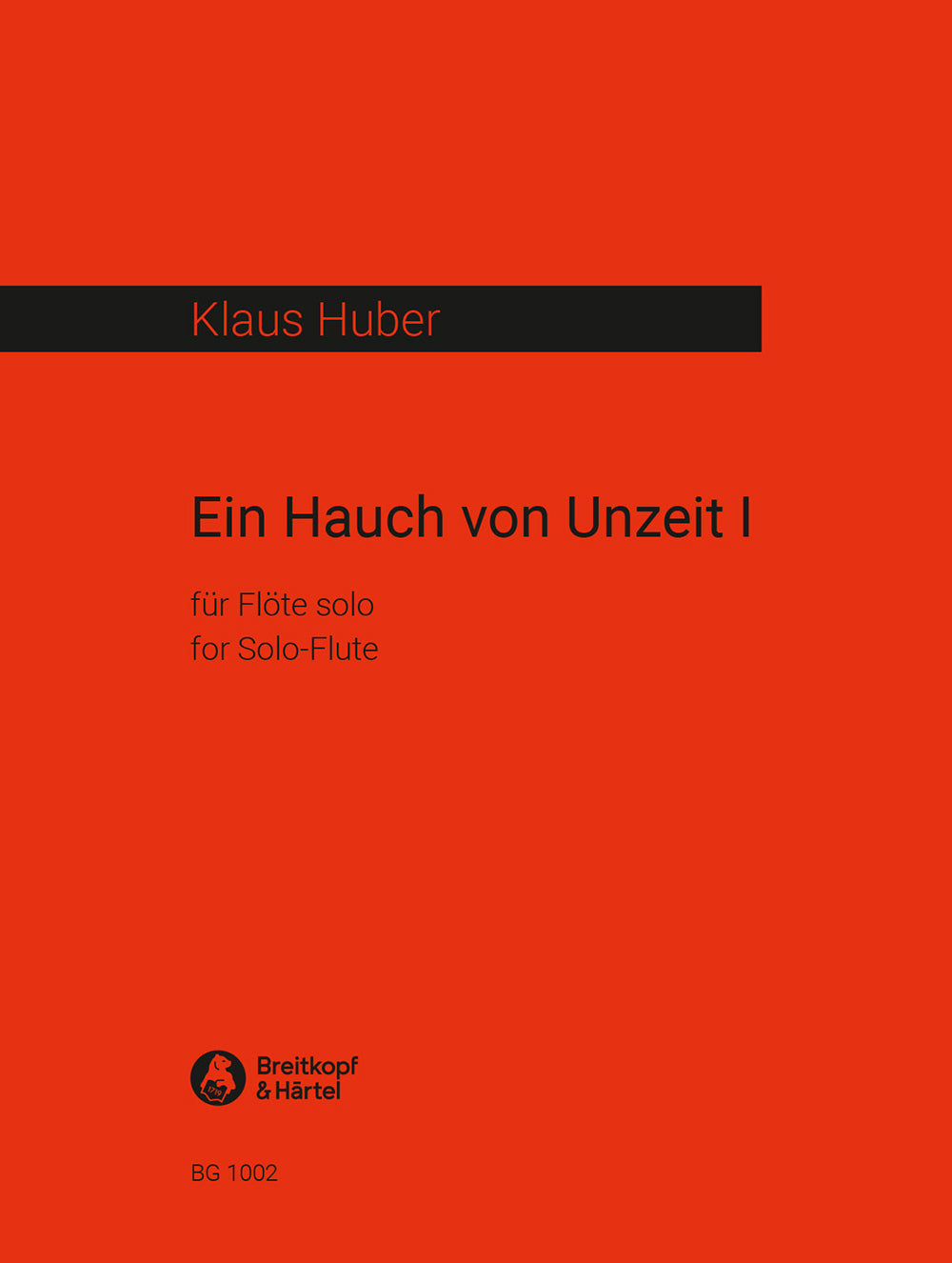Huber: Ein Hauch von Unzeit I
In stock and typically ships within 1 business day.
- Composer: Klaus Huber (1924-2017)
- Instrumentation: Flute
- Work: Ein Hauch von Unzeit
- ISMN:
- Size: 9.1 x 12.0 inches
- Pages: 12
Description
World premières: I version for flute: Wiesbaden, 1972 II version for piano: Nyon, 1972 III version for var. insts.: Cologne, May 29, 1976 VI version for accordeon: Fribourg, June 25, 1987 VIII version for cello Tokyo: October 14, 1989 X version for organ: Stuttgart, March 28, 2018
This work ("A Breath of the Untimely") was first written for solo Flute and dedicated to Aurèle Nicolet. Its bears the subtitle "Lament on the Loss of Musical Thought -- some Madrigals for Solo Flute or Flute with any other Instruments". This serves as a playing instruction but doubles at the same time as an "outmoded" programme: it refers back to the musical origin of the opening lamenting motif, a tradition which was once of its time but is not of our time - namely the Lamento genre which gave the title to the Chaconne in Purcell's opera "Dido and Aeneas." Almost simultaneously I wrote a second version for Piano ("for Piano one-and-a-half hands"), which already formulates possible approaches for the performer, in some detail, to the indicated, quasi-canonic version of the piece in the "programme." The multiple version "Ein Hauch von Unzeit III" realizes a concrete version of a formal state which floats between strict canon and aleatoric principles: each of the musicians who are spread throughout the hall introduces their own "idiomatic translation" of the flute part. and so the music exists, omnipresent, not only spatially throughout the hall, but also formally in a sort of "fluctuating simultaneity." for that reason, it was my express wish to any potential interpreter that they should construct entirely their own version of the piece. A healthy number of musicians have responded to my suggestion - versions of the piece have now been made for guitar (Cornelius Schwehr, Gunther Schneider), accordion (Hugo Noth), double bass (Fernando Grillo), violin (Hansheinz Schneeberger), viola, cello, and double bass (trio basso, Köln), cello (Michael Bach), trombone (Andrew Digby) and, created by myself, a sung version for voice (to words by Georg Wilhelm Friedrich Hegel and Max Bense), and for viola.
The most important requirement for the whole piece is absolute stillness, which should as far as possible emanate from the performer. The pauses are occasionally in this respect the most important element. These may, if one can find the necessary stillness, become very long. "Ein Hauch von Unzeit" (A Breath of the Untimely) -- time almost dissolves!
(Klaus Huber, 1989/2014 -- translation: David Alberman)
Publishers use a lot of words to describe what they sell, and we know it can be confusing. We've tried to be as clear as possible to make sure you get exactly what you are looking for. Below are descriptions of the terms that we use to describe the various formats that music often comes in.
Choral Score
A score for vocalists that only contains the vocal lines. The instrumental parts are not there for reference. Generally, cheaper than a vocal score and requires multiple copies for purchase.
Facsimile
Reproductions of the original hand-written scores from the composer.
Full Score
For ensemble music, this indicates that the edition contains all parts on a single system (there are not separate parts for each player). In larger ensembles, this is for the conductor.
Hardcover
Hardbound. Generally either linen-covered or half-leather.
Orchestral Parts
Similar to a wind set, this is a collection of parts. In the case of strings, the numbers listed are the number of copies included, though generally these are available individually (often with minimum quantities required).
Paperback
When publishers offer multiple bindings (e.g. hardcover) or study scores, this is the "standard" version. If you're planning to play the music, this is probably what you want.
Performance / Playing Score
A score of the music containing all parts on one system, intended for players to share. There are not separate parts for each player.
Set of Parts
For ensemble music, this indicates that there are separate individual parts for each player.
Solo Part with Piano Reduction
For solo pieces with orchestra, this is a version that contains a piano reduction of the orchestra parts. For piano pieces, two copies are typically needed for performance.
Study Score
A small (think choral size) copy of the complete score meant for studying, and not playing. They make great add-ons when learning concertos and small chamber works.
Vocal Score
A score prepared for vocalists that includes the piano/organ part or a reduction of the instrumental parts.
Wind Set
For orchestral music, this is a collection of wind and percussion parts. The specific quantities of each instrument are notated.
With Audio
In addition to the printed music, the edition contains recordings of the pieces. This may be an included CD, or access to files on the internet.
With / Without Fingering (Markings)
Some publishers prepare two copies - a pure Urtext edition that includes no fingering (or bowing) suggestions and a lightly edited version that includes a minimal number of editorial markings.



